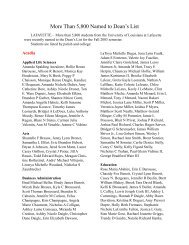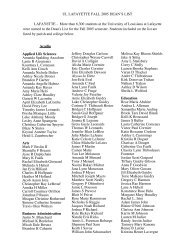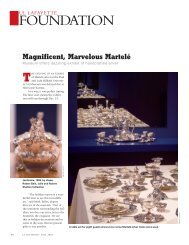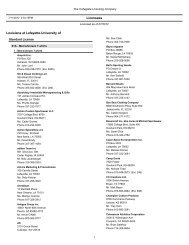22 la louisiane | spring 2010 - University of Louisiana at Lafayette
22 la louisiane | spring 2010 - University of Louisiana at Lafayette
22 la louisiane | spring 2010 - University of Louisiana at Lafayette
You also want an ePaper? Increase the reach of your titles
YUMPU automatically turns print PDFs into web optimized ePapers that Google loves.
above: Bryant Meyer, a senior<br />
studying n<strong>at</strong>ural resources and<br />
environmental quality, checks<br />
a sample <strong>of</strong> algae being grown<br />
in sugar-mill wastew<strong>at</strong>er in an<br />
incub<strong>at</strong>or th<strong>at</strong> uses leD lighting.<br />
right: this algae bioreactor,<br />
made from a 55-gallon drum,<br />
is used to study how leD light<br />
affects algae growth <strong>at</strong> various<br />
w<strong>at</strong>er depths.<br />
and other species.<br />
Benson is interested in dead<br />
zone w<strong>at</strong>er because “it is like wastew<strong>at</strong>er. It’s very high in<br />
nitrogen, phosophorus and carbon dioxide.” She hopes to<br />
develop wastew<strong>at</strong>er remedi<strong>at</strong>ion processes, using algae to<br />
improve w<strong>at</strong>er quality, while producing oil.<br />
Benson used samples <strong>of</strong> algae and w<strong>at</strong>er taken from<br />
the dead zone and cultured them in the <strong>la</strong>b. “We were<br />
impressed with the levels <strong>of</strong> growth <strong>of</strong> biomass, and they<br />
32 LA LOUISIANE | SPRING <strong>2010</strong><br />
‘louISIana IS the BeSt aMong<br />
all the St<strong>at</strong>eS for algae<br />
proDuCtIon, BeCauSe <strong>of</strong> ItS<br />
ClIM<strong>at</strong>e anD the preSenCe <strong>of</strong><br />
refInery anD DIStrIButIon<br />
faCIlItIeS.‘<br />
DaVID JohnSton, Ceo, aQu<strong>at</strong>IC energy<br />
also produced a decent amount <strong>of</strong> lipids.”<br />
She’s looking more closely <strong>at</strong> a type <strong>of</strong> algae<br />
found in the dead zone, cyanobacteria, or bluegreen<br />
algae.<br />
“It’s an amazingly adaptable organism,”<br />
she said. Like most algae, cyanobacteria grows<br />
in light. But it also grows in darkness. When it<br />
does, it increases oil production and also produces<br />
ethanol.<br />
“So, there’s a possibility you could cre<strong>at</strong>e a<br />
mixed scenario. Cultiv<strong>at</strong>e them phototrophically<br />
for a while, to encourage growth, then<br />
grow them under stressed conditions to get<br />
the lipid content and ethanol production you<br />
want,” Benson said.<br />
She also p<strong>la</strong>ns to study the growth <strong>of</strong> algae<br />
in wastew<strong>at</strong>er gener<strong>at</strong>ed during sugarcane<br />
processing. “A certain amount <strong>of</strong> sugar is left<br />
behind in the waste stream. We want to know<br />
which strains <strong>of</strong> algae grow best in th<strong>at</strong> type <strong>of</strong><br />
wastew<strong>at</strong>er.”<br />
The most cost-efficient<br />
way to grow algae<br />
commercially is in open<br />
ponds. Harry Daultani,<br />
a gradu<strong>at</strong>e student in<br />
chemical engineering <strong>at</strong><br />
UL <strong>Lafayette</strong>, is investig<strong>at</strong>ing<br />
the potential for<br />
growing algae indoors,<br />
under LED lighting.<br />
“If you’re growing<br />
algae under a fullspectrum<br />
light, you’re<br />
wasting energy, because<br />
algae doesn’t need the full<br />
spectrum to grow. They mostly need red and blue light,”<br />
he exp<strong>la</strong>ined.<br />
Light-emitting diodes use minimum energy and can<br />
be designed to emit light <strong>at</strong> specific frequencies, or colors.<br />
In the algae <strong>la</strong>b, Daultani lowers a modified measuring<br />
stick into a blue p<strong>la</strong>stic, 55-gallon drum, an algae<br />
bioreactor. A series <strong>of</strong> s<strong>of</strong>tly glowing red and blue lights are<br />
positioned across the top <strong>of</strong> the tank.<br />
The light shining down in the w<strong>at</strong>er fades, or <strong>at</strong>tenu<strong>at</strong>es.<br />
Daultani uses light sensors, positioned inside the tank,<br />
to measure the strength <strong>of</strong> the light <strong>at</strong> different levels.<br />
“I’m looking <strong>at</strong> light dynamics, how the light behaves<br />
in the reactor and how the algae respond to the light.”<br />
Daultani is collecting d<strong>at</strong>a to design a <strong>la</strong>rge-scale, costeffective<br />
reactor.<br />
UL <strong>Lafayette</strong> is conducting research for Aqu<strong>at</strong>ic<br />
Energy LLC, testing solvents for algal oil extraction.<br />
The company, based in Lake Charles, La., is developing<br />
technology and facilities to turn freshw<strong>at</strong>er algae into fuel<br />
and food.<br />
Aqu<strong>at</strong>ic Energy oper<strong>at</strong>es pilot facilities in Cameron,<br />
Calcasieu and Allen parishes. “We’ve been selecting our<br />
algae strains, domestic<strong>at</strong>ing them, getting them to go
















